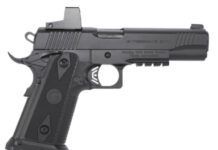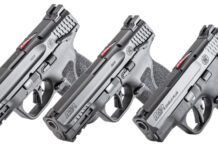Like most Beretta’s we’ve opened a box on, the Teknys Gold Sporting is immediately eye-catching. Our sample sported a chocolate-cherry piece of wood that while not fancily figured, showed some very handsome striation. With an oil finish that’s polished enough to look like a lacquer finish, this stock is nice enough that it justifies the gun’s steeper price tag.
The buttstock, as is typical for many Berettas, is tall at its buttplate end. There’s a lot of wood back there, in part because it accommodates Beretta’s super-comfy Gel-Tek recoil pad. Now, the Teknys also comes with a standard soft-rubber pad, but we love the extra-smooth heel and toe of the Gel-Tek so much, not to mention its added ability to absorb recoil, that we can imagine only one reason why anyone would want to switch the two out. That reason is fit.
While both pads are the same width at the center point, the Gel-Tek pad has a more pronounced concave design than the standard rubber pad. It also has a more pronounced heel and toe. However, it wasn’t that the design was so visually exaggerated, but more that its configuration created a near glove fit for tall women or average-height men (roughly 5 feet 9 inches. In fact, our testers said that the pad aided in the consistency of the gun-to-shoulder placement during mounting. The heel and toe “bumps” helped prevent canting. As most competitive shooters who employ a low mount know, consistency in the mount and gun placement on the shoulder are half the battle in gaining more Xs. We feel that all but the smallest shooters will appreciate the benefits of the concave Gel-Tek pad on the Technys. And for those who don’t, they have the alternate pad available.
There’s also a shim kit included for altering pitch and cast. Beretta gets more than a few points for recognizing the variety of shooter sizes and making one gun more fit many people by providing accessories that accommodate such diversity.
We felt strongly, too, about gun fit as it pertained to the rest of the Teknys’ stock. The pistol grip pulls cleanly and deeply away from the receiver and trigger guard. This has two advantages.
First, it accommodates a wide range of hand sizes; even the ham-fisted will find ample room on this gun. Second, it appears to be designed to keep the hand closely in line with the cheek and eye, like a well-thought-out rifle stock (in fact, while not as extreme in its curve, it’s not a far departure from the handgrip designs on many tactical rifles). Combined with the very straight top line of the stock to the slight upsweep of the receiver’s corrugated top sighting channel, this is one the cleanest mounting guns we’ve shot in a long time. It came up dead-on straight every time without trying—no canting, no fishing around for a different hand position to tilt the gun one way or another.
Another aid to mounting and a good view was the sighting channel we just mentioned. Most semi-auto shotguns have a set of grooves in their receiver tops, but Beretta really does this detail justice. There are 10 grooves carved deeply within the quarter-inch-wide channel, which will never appear to the shooter with the gun mounted properly (i.e., the shooter will see no ramping to the muzzle-end bead or sight). What will appear is the shadow created by the divot carved out of the back of the plane. With the gun mounted properly, the notch appears as a short, dark grey horizontal line at the receiver’s top. In effect, it’s a sight of sorts; not one the shooter will use to aim, of course, but when kept in the periphery of the vision, the shooter can instantly tell if his head is on the stock and properly in line. Head too high, the gray line disappears and the ramp shows. Cant the gun, and the line’s pitch is distorted. We found this to be a nice reference aid during dry-mount practice.
Moving on to the forend, we noted the Teknys gun’s front wood is long, nearly a full inch longer than the Browning’s. It is consistently trim (no belly on this one) from beginning to end. The wood is well-matched in quality, coloring, and figuring to that of the butt stock, and it exhibits some exceptionally tight checkering that runs from midway under the forend up to the thumb-roll indent at the side, and nearly halfway past the gas vents at the end. Taller, longer armed shooters will see the immediate benefits in the forearm’s length, while large hands won’t feel like they’re handling a matchstick.
The Teknys receiver sports an underside that is un-belled and well in line with the forend. Curving up and back a bit to rise over the trigger guard and up into the high curve of the pistol grip, sculpting of the receiver’s lower edges emphasizes the gun’s aggressive looks.
The receiver, composed of a high-strength aluminum alloy, has a softly brushed finish, and the overall fit and finish between the receiver and buttstock and on wood edges are very good. On both sides of the receiver appears a blue enamel teardrop-shaped inlay, featuring the Beretta trident at the round. (The pointed end of this inlay is actually placed over the wood of the pistol grip within the checkering.) On the non-ejection side of the receiver is a thoroughly modern rendition of the Beretta trident, cleverly laid out in a way so as to emphasize the gun’s “forward” looks.
And “forward” looks this gun does indeed have. The Teknys has a positive, aggressive appearance, one that says “go to the target.” We think this gun is quite the looker.
We were even more pleased that the gun’s shootability echoes its go-get-’em appearance. With just the right amount of forward balance, in our opinion the Teknys really did go right to the target. We found ample precision with this one, making the breaks consistently even when varying our choice of crush points. To us, that demonstrates a remarkably flexible shotgun.
The Teknys is not the fastest semi-auto we’ve ever shot, in terms of handling, but it was no sluggard, either. It did require a bit more push on fast, close-in presentations, but our test shooters managed to break skeet station No. 8 high and low from a low mount and before the stake — and with an improved choke — more times than not. Though we had to concentrate more on a stronger approach to such targets, this one was steady as a rock on longer presentations where long visual air times that can contribute to extended tracking
Functionally, the gun never failed. From the lightest Winchester X-Lite target loads to full 3-dram equiv Remington Nitros, this gun loaded and ejected without flaw and regardless of the combination in which shells were loaded. We were especially impressed that it handled the Winchester X-Lites, as the gun is designed to accommodate 3-inch shells. In our opinion, there are far too many autoloaders on the market today that chamber the 3-inch 12-gauge, but don’t function well with the lightest 2.75-inch loads.
We also found loading to be easy — no pinched gloves or fingers in the receiver underside loading into the magazine, and the bolt was smooth as glass; we never really noticed it cycling during operation. We also didn’t notice much muzzle rise between shots, even with heavy 3-DE loads, and this gun’s not ported. We think this speaks volumes about the mechanical design of the gas system and its ability to redirect recoil without punishing the shooter on either end. Finally, the Teknys’ trigger broke as crisply as a semi-automatic shotgun trigger can be expected to break, with an average pull weight of 4.5 pounds.
Five chokes are supplied with this gun, and they are both extended and well marked in both writing and color to easily and quickly identify the constriction. We had no trouble screwing and unscrewing these tubes and liked that the threads weren’t overly long. The barrel has an integral fiber-optic site in day-glo green, and the works come in a nice, well-organized break-down hard case.































